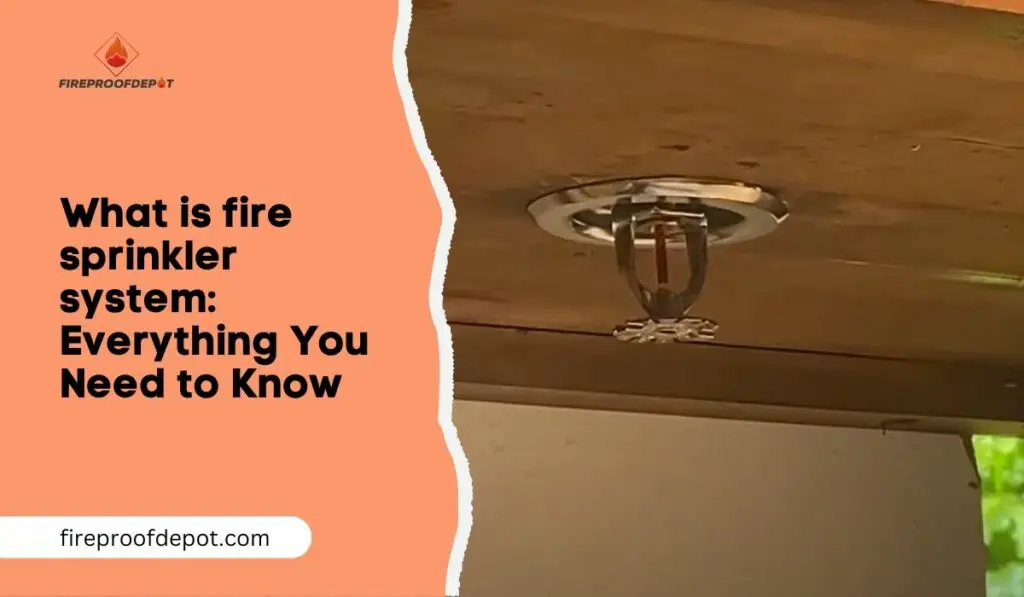
A fire sprinkler system is a vital and sophisticated safety measure designed to protect lives and property from the devastating effects of fires.
Comprising a network of pipes, valves, and sprinkler heads, this ingenious system is installed in buildings to detect and extinguish fires in their early stages.
Through this article, you will get to learn about the components, different types, and the working process of the sprinkler system.
Components of the System
A fire sprinkler system comprises various components working together to detect and suppress fires effectively. Each element plays a critical role in ensuring the system’s functionality and reliability.
| Component | Description |
| Sprinkler Heads | Mounted on pipes, these automatically release water when activated by heat, targeting the fire directly. The heads come in different types, such as pendant, upright, sidewall, and concealed. |
| Pipes | The network of pipes distributes water throughout the building, connecting to the sprinkler heads. |
| Water Supply | A reliable water supply source, such as a municipal water connection or a dedicated water storage tank, ensures an adequate water flow for the sprinkler system to operate effectively. |
| Valves and Fittings | Control valves regulate water flow, and check valves prevent backflow in certain system designs. Fittings, such as elbows and tees, facilitate pipe connections and changes in direction. |
| Alarm Devices | Smoke or heat detectors trigger alarms when they sense a fire, alerting occupants and initiating the sprinkler system, providing an early warning. |
| Control Panel | The control panel monitors the system’s status, displays alarms, and manages water flow. It allows manual intervention and communicates with other fire safety systems in the building. |
| Water Motor Gong | An audible water motor gong sounds when water flows through the system, providing an additional alarm signal. |
| Pressure Gauges | Pressure gauges measure the water pressure in the system, enabling proper maintenance and ensuring the system is ready for operation. |
| Waterflow Switches | Waterflow switches detect the flow of water in the system and activate alarms or alert monitoring services. |
What are the benefits of using fire sprinkler systems?
Using fire sprinkler systems can provide you with different benefits, including the following:
- Sprinklers can quickly suppress fires, giving occupants more time to evacuate safely.
- They minimize fire damage, reducing repair and reconstruction costs.
- Some systems detect fires automatically, alerting occupants and emergency services promptly.
- Sprinklers use less water than fire fighting hoses, reducing water damage.
- They complement other fire safety measures, improving overall building protection.
- Installing sprinklers may lead to lower insurance costs for the property owner.
- They help minimize the environmental impact of fires by limiting their size and intensity.
Types Of Fire Sprinkler Systems
There are various types of fire sprinkler systems, each designed to suit different building layouts, occupancies, and fire protection needs. Here are the main types:
Wet Pipe Sprinkler System
This is the most common one. Water is constantly present in the pipes, and when a sprinkler head is activated by heat from a fire, the water immediately discharges onto the flames.
Dry Pipe Sprinkler System
In areas where freezing temperatures can occur, a dry pipe system is used. Compressed air or nitrogen fills the pipes, and when a sprinkler head is activated, the air is released, allowing the water to flow and extinguish the fire.
Pre-Action Sprinkler System
This system is suitable for locations with valuable or sensitive items that could be damaged by accidental sprinkler discharge. It requires two activation events: first, a smoke or heat detector must detect a fire, and then the sprinkler heads are triggered to release water.
Deluge Sprinkler System
This system is employed in high-hazard areas, such as chemical storage facilities or power plants. All sprinkler heads in the system activate simultaneously when a fire is detected, quickly flooding the area with water.
ESFR Sprinkler System
ESFR sprinklers are designed to suppress high-challenge fires in large, open spaces quickly. They use a high flow rate to control the fire without the need for additional in-rack sprinklers.
How Can I Prevent Fire Sprinkler System Failure?
It is crucial to take measures to prevent fire sprinkler system failure consequences. Regular maintenance and inspections help ensure the system’s proper functioning. Adequate training for staff on how to handle the system correctly and promptly address any issues is essential. Additionally, avoiding physical damage to sprinkler heads and keeping the system clear of obstructions can greatly minimize the risk of failure.
How Fire Sprinkler Systems Work?
Fire sprinkler systems work in a complex process. Here is how the system works:
- Water is always present in the pipes, keeping the system primed for action.
- When a fire starts, the heat causes the sprinkler head’s temperature-sensitive element to activate.
- The activated sprinkler head releases water into the fire below.
- Each sprinkler head operates independently, targeting the fire’s immediate area.
- The water flow helps cool the surrounding environment, limiting the fire’s spread and reignition potential.
- Sprinklers provide rapid response, controlling the fire until firefighters arrive.
- The system operates automatically, ensuring immediate response even when occupants are absent or unaware of the fire.
Conclusion
A fire sprinkler system is a vital safety mechanism designed to detect and suppress fires in their early stages.
Its quick response, accuracy, and ability to protect lives and property make it an indispensable asset in promoting fire safety and minimizing potential losses.
